Different Relationships between Arctic Oscillation and Ozone in the Stratosphere over the Arctic in January and February
Abstract
1. Introduction
2. Datasets and Methods
2.1. Datasets
2.2. Methods
3. Relationship between the AO and Ozone in the Lower Stratosphere over the Arctic
4. Underlying Mechanisms
4.1. Changes in the Spatial Pattern of AO
4.2. Anomalies in Wave Propagation
4.3. Anomalies in Stratospheric Circulation
5. Discussion and Conclusions
Author Contributions
Funding
Data Availability Statement
Acknowledgments
Conflicts of Interest
References
- Thompson, D.W.J.; Wallace, J.M. The Arctic oscillation signature in the wintertime geopotential height and temperature fields. Geophys. Res. Lett. 1998, 25, 1297–1300. [Google Scholar] [CrossRef]
- Thompson, D.W.J.; Wallace, J.M.; Hegerl, G.C. Annular Modes in the Extratropical Circulation. Part II Trends. J. Clim. 2000, 13, 1018–1036. [Google Scholar] [CrossRef]
- Thompson, D.W.J.; Wallace, J.M. Annular Modes in the Extratropical Circulation. Part I: Month-to-Month Variability. J. Clim. 2000, 13, 1000–1016. [Google Scholar] [CrossRef]
- Thompson, D.W.J.; Li, Y. Baroclinic and Barotropic Annular Variability in the Northern Hemisphere. J. Atmos. Sci. 2015, 72, 1117–1136. [Google Scholar] [CrossRef]
- Hassanzadeh, P.; Kuang, Z. Blocking variability: Arctic Amplification versus Arctic Oscillation. Geophys. Res. Lett. 2015, 42, 8586–8595. [Google Scholar] [CrossRef]
- Ambaum, M.H.P.; Hoskins, B.J.; Stephenson, D.B. Arctic oscillation or North Atlantic oscillation. J. Clim. 2001, 14, 3495–3507. [Google Scholar] [CrossRef]
- Hu, D.; Guo, Y.-P.; Tan, Z.-M.; Guan, Z. Interannual Relationship between the Boreal Spring Arctic Oscillation and the Northern Hemisphere Hadley Circulation Extent. J. Clim. 2019, 32, 4395–4408. [Google Scholar] [CrossRef]
- Gong, H.; Wang, L.; Chen, W.; Wu, R.; Zhou, W.; Liu, L.; Nath, D.; Lan, X. Diversity of the Wintertime Arctic Oscillation Pattern among CMIP5 Models: Role of the Stratospheric Polar Vortex. J. Clim. 2019, 32, 5235–5250. [Google Scholar] [CrossRef]
- Baldwin, M.P.; Dunkerton, T.J. Stratospheric Harbingers of Anomalous Weather Regimes. Science 2001, 294, 581–584. [Google Scholar] [CrossRef]
- Xie, F.; Li, J.; Zhang, J.; Tian, W.; Hu, Y.; Zhao, S.; Sun, C.; Ding, R.; Feng, J.; Yang, Y. Variations in North Pacific Sea Surface Temperature Caused by Arctic Stratospheric Ozone Anomalies. Environ. Res. Lett. 2017, 12, 114023. [Google Scholar] [CrossRef]
- Xie, F.; Li, J.; Tian, W.; Fu, Q.; Jin, F.F.; Hu, Y.; Zhang, J.; Wang, W.; Sun, C.; Feng, J.; et al. A connection from Arctic stratospheric ozone to El Niño-Southern oscillation. Environ. Res. Lett. 2016, 11, 124026. [Google Scholar] [CrossRef]
- Zhang, J.; Tian, W.; Xie, F.; Sang, W.; Guo, D.; Chipperfield, M.; Feng, W.; Hu, D. Zonally asymmetric trends of winter total column ozone in the northern middle latitudes. Clim. Dynam. 2018, 52, 4483–4500. [Google Scholar] [CrossRef]
- World Meteorological Organization (WMO). Scientific Assessment of Ozone Depletion: 2014, Global Ozone Research and Monitoring World Meteorological Organization (WMO); Project—Report No. 55; World Meteorological Organization (WMO): Geneva, Switzerland, 2014; p. 416. [Google Scholar]
- Douglass, A.R.; Rood, R.B.; Stolarski, R.S. Interpretation of ozone temperature correlations: 2. Analysis of SBUV ozone data. J. Geophys. Res. Atmos. 1985, 90, 10693–10708. [Google Scholar] [CrossRef]
- Rood, R.B.; Douglass, A.R. Interpretation of ozone temperature correlations: 1. Theory. J. Geophys. Res. 1985, 90, 5733. [Google Scholar] [CrossRef]
- Hartmann, D.L. Some aspects of the coupling between radiation, chemistry, and dynamics in the stratosphere. J. Geophys. Res. 1981, 86, 9631. [Google Scholar] [CrossRef]
- Zhang, J.; Xie, F.; Tian, W.; Han, Y.; Zhang, K.; Qi, Y.; Chipperfield, M.; Feng, W.; Huang, J.; Shu, J. Influence of the Arctic Oscillation on the Vertical Distribution of Wintertime Ozone in the Stratosphere and Upper Troposphere over the Northern Hemisphere. J. Clim. 2017, 30, 2905–2919. [Google Scholar] [CrossRef]
- Liu, Y.; He, S.; Li, F.; Wang, H.; Zhu, Y. Unstable relationship between the Arctic Oscillation and East Asian jet stream in winter and possible mechanisms. Theor. Appl. Climatol. 2019, 135, 13–27. [Google Scholar] [CrossRef]
- Li, F.; Wang, H.; Gao, Y. On the Strengthened Relationship between the East Asian Winter Monsoon and Arctic Oscillation: A Comparison of 1950–1970 and 1983–2012. J. Clim. 2014, 27, 5075–5091. [Google Scholar] [CrossRef]
- Hu, D.; Tian, W.; Xie, F.; Shu, J.; Dhomse, S. Effects of Meridional Sea Surface Temperature Changes on Stratospheric Temperature and Circulation. Adv. Atmos. Sci. 2014, 31, 888–900. [Google Scholar] [CrossRef]
- Liu, M.; Hu, D.; Zhang, F. Connections between Stratospheric Ozone Concentrations Over the Arctic and Sea Surface Temperatures in the North Pacific. J. Geophys. Res. Atmos. 2020, 125, D031690. [Google Scholar] [CrossRef]
- Young, P.J.; Rosenlof, K.H.; Solomon, S.; Sherwood, S.C.; Fu, Q.; Lamarque, J. Changes in Stratospheric Temperatures and Their Implications for Changes in the Brewer–Dobson Circulation, 1979–2005. J. Clim. 2012, 25, 1759–1772. [Google Scholar] [CrossRef]
- Efstathiou, M.N.; Varotsos, C.A.; Singh, R.P.; Cracknell, A.P.; Tzanis, C. On the longitude dependence of total ozone trends over middle-latitudes. Int. J. Remote Sens. 2003, 24, 1361–1367. [Google Scholar] [CrossRef]
- Hu, Y.; Tung, K.K.; Liu, J. A Closer Comparison of Early and Late-Winter Atmospheric Trends in the Northern Hemisphere. J. Clim. 2005, 18, 3204–3216. [Google Scholar] [CrossRef][Green Version]
- Zhou, S.; Miller, A.J.; Wang, J.; Angell, J.K. Trends of NAO and AO and their associations with stratospheric processes. Geophys. Res. Lett. 2001, 28, 4107–4110. [Google Scholar] [CrossRef]
- Rienecker, M.M.; Suarez, M.J.; Gelaro, R.; Todling, R.; Bacmeister, J.; Liu, E.; Bosilovich, M.G.; Schubert, S.D.; Takacs, L.; Kim, G.; et al. MERRA: NASA’s Modern-Era Retrospective Analysis for Research and Applications. J. Clim. 2011, 24, 3624–3648. [Google Scholar] [CrossRef]
- Raj, S.T.A.; Ratnam, M.V.; Rao, D.N.; Murthy, B.V.K. Vertical distribution of ozone over a tropical station: Seasonal variation and comparison with satellite (MLS, SABER) and ERA-Interim products. Atmos. Environ. 2015, 116, 281–292. [Google Scholar]
- Bhartia, P.K.; McPeters, R.D.; Flynn, L.E.; Taylor, S.; Kramrova, N.A.; Frith, S.; Fisher, B.; de Land, M. Solar Backscatter UV (SBUV) total ozone and profile algorithm. Atmos. Meas. Tech. Discuss. 2012, 5, 5913–5951. [Google Scholar] [CrossRef]
- Livesey, N.J.; Read, W.G.; Froidevaux, L.; Lambert, A.; Manney, G.L.; Pumphrey, H.C.; Santee, M.L.; Schwartz, M.J.; Wang, S.; Cofield, R.E. Version 3.3 Level 2 Data Quality and Description Document. JPL D-33509; Jet Propul. Lab.: Pasadena, CA, USA, 2011. [Google Scholar]
- Gelaro, R.; Mccarty, W.; Suarez, M.J.; Todling, R.; Molod, A.; Takacs, L.L.; Randles, C.A.; Darmenov, A.; Bosilovich, M.G.; Reichle, R.H. The Modern-Era Retrospective Analysis for Research and Applications, Version 2 (MERRA-2). J. Clim. 2017, 30, 5419–5454. [Google Scholar] [CrossRef]
- Kaihatu, J.M.; Handler, R.A.; Marmorino, G.O.; Shay, L.K. Empirical Orthogonal Function Analysis of Ocean Surface Currents Using Complex and Real-Vector Methods. J. Atmos. Ocean. Tech. 1998, 15, 927–941. [Google Scholar] [CrossRef]
- North, G.R.; Bell, T.L.; Cahalan, R.F.; Moeng, F.J. Sampling Errors in the Estimation of Empirical Orthogonal Functions. Mon. Weather Rev. 1982, 110, 699. [Google Scholar] [CrossRef]
- Monier, E.; Weare, B.C. Climatology and trends in the forcing of the stratospheric ozone transport. Atmos. Chem. Phys. 2011, 11, 6311–6323. [Google Scholar] [CrossRef]
- Andrews, D.G.; Holton, J.R.; Leovy, C.B. Middle Atmosphere Dynamics; Academic Press: Cambridge, MA, USA, 1987. [Google Scholar]
- Li, F.; Wang, H.; Liu, J. The strengthening relationship between Arctic Oscillation and ENSO after the mid-1990s. Int. J. Clim. 2014, 34, 2515–2521. [Google Scholar] [CrossRef]
- Oman, L.D.; Douglass, A.R.; Ziemke, J.R.; Rodriguez, J.M.; Waugh, D.W.; Nielsen, J.E. The ozone response to ENSO in Aura satellite measurements and a chemistry-climate simulation. J. Geophys. Res. Atmos. 2013, 118, 965–976. [Google Scholar] [CrossRef]
- Tegtmeier, S.; Rex, M.; Wohltmann, I.; Krüger, K. Relative importance of dynamical and chemical contributions to Arctic wintertime ozone. Geophys. Res. Lett. 2008, 35, 2008GL034250. [Google Scholar] [CrossRef]
- Lubis, S.W.; Silverman, V.; Matthes, K.; Harnik, N.; Omrani, N.; Wahl, S. How does downward planetary wave coupling affect polar stratospheric ozone in the Arctic winter stratosphere? Atmos. Chem. Phys. 2017, 17, 2437–2458. [Google Scholar] [CrossRef]
- Cohen, J.; Barlow, M.; Kushner, P.J.; Saito, K. Stratosphere–Troposphere Coupling and Links with Eurasian Land Surface Variability. J. Clim. 2007, 20, 5335–5343. [Google Scholar] [CrossRef]
- Hu, D.; Guan, Z. Decadal Relationship between the Stratospheric Arctic Vortex and Pacific Decadal Oscillation. J. Clim. 2018, 31, 3371–3386. [Google Scholar] [CrossRef]
- Hu, D.; Tian, W.; Xie, F.; Wang, C.; Zhang, J. Impacts of stratospheric ozone depletion and recovery on wave propagation in the boreal winter stratosphere. J. Geophys. Res. Atmos. 2015, 120, 8299–8317. [Google Scholar] [CrossRef]
- Chen, P.; Robinson, W.A. Propagation of planetary waves between the troposphere and stratosphere. J. Atmos. Sci. 1992, 49, 2533–2545. [Google Scholar] [CrossRef]
- Raddatz, R.L.; Candlish, L.M.; Asplin, M.G.; Barber, D.G. Static Stability of the Troposphere over the Southeastern Beaufort Sea-Amundsen Gulf Region of the Western Maritime Arctic. Atmos. Ocean. 2016, 54, 22–31. [Google Scholar] [CrossRef]
- Hu, D.; Guo, Y.; Wang, F.; Xu, Q.; Li, Y.; Sang, W.; Wang, X.; Liu, M. Brewer–Dobson Circulation: Recent-Past and Near-Future Trends Simulated by Chemistry-Climate Models. Adv. Meteorol. 2017, 2017, 2913895. [Google Scholar] [CrossRef]
- Chen, D.; Wang, H.; Sun, J.; Gao, Y. Pacific multi-decadal oscillation modulates the effect of Arctic oscillation and El Niño southern oscillation on the East Asian winter monsoon. Int. J. Climatol. 2018, 38, 2808–2818. [Google Scholar] [CrossRef]
- Park, H.; Ahn, J. Combined effect of the Arctic Oscillation and the Western Pacific pattern on East Asia winter temperature. Clim. Dynam. 2016, 46, 3205–3221. [Google Scholar] [CrossRef]
- Zhang, J.; Tian, W.; Xie, F.; Chipperfield, M.P.; Feng, W.; Son, S.; Abraham, N.L.; Archibald, A.T.; Bekki, S.; Butchart, N.; et al. Stratospheric ozone loss over the Eurasian continent induced by the polar vortex shift. Nat. Commun. 2018, 9, 206. [Google Scholar] [CrossRef] [PubMed]
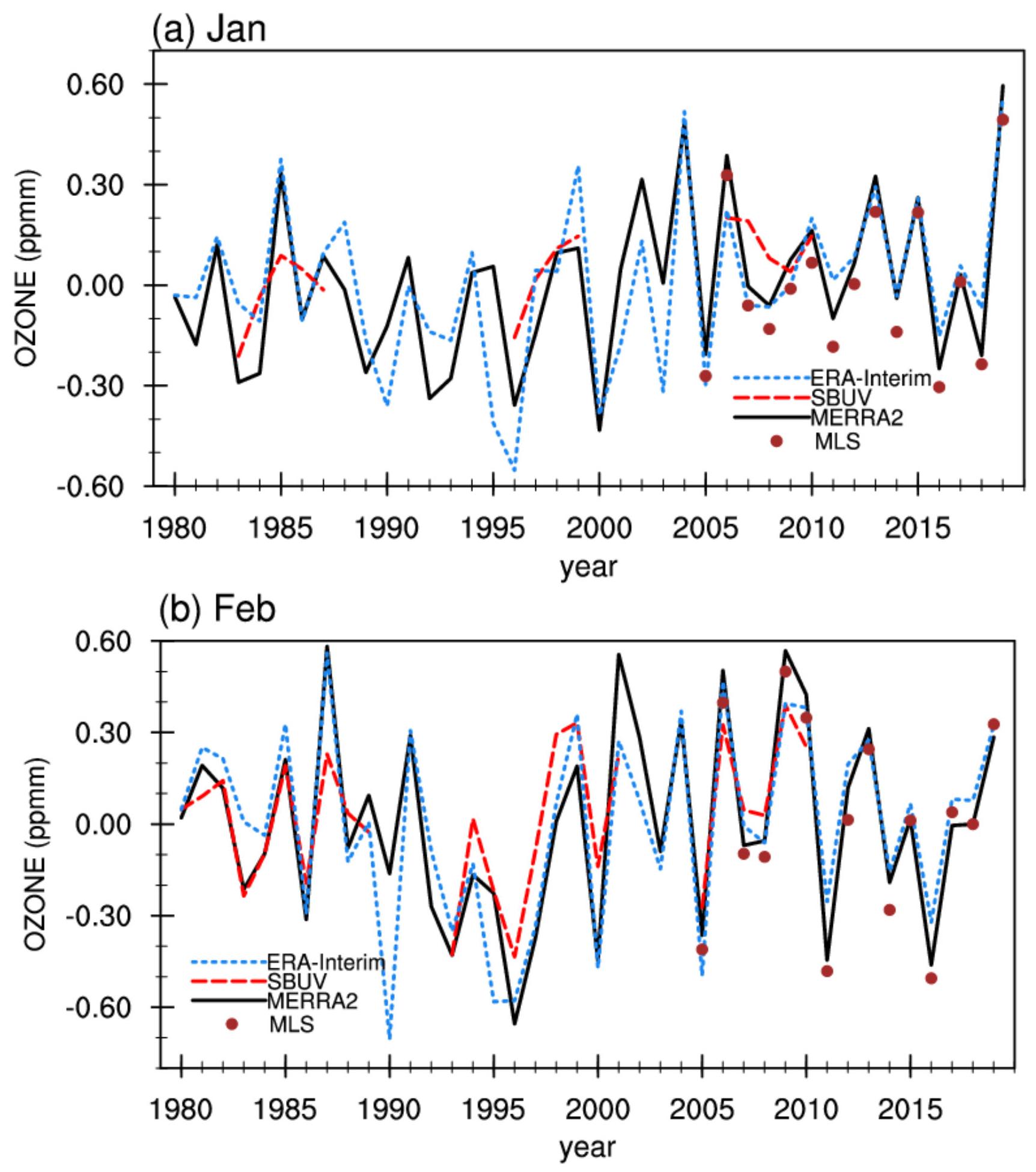

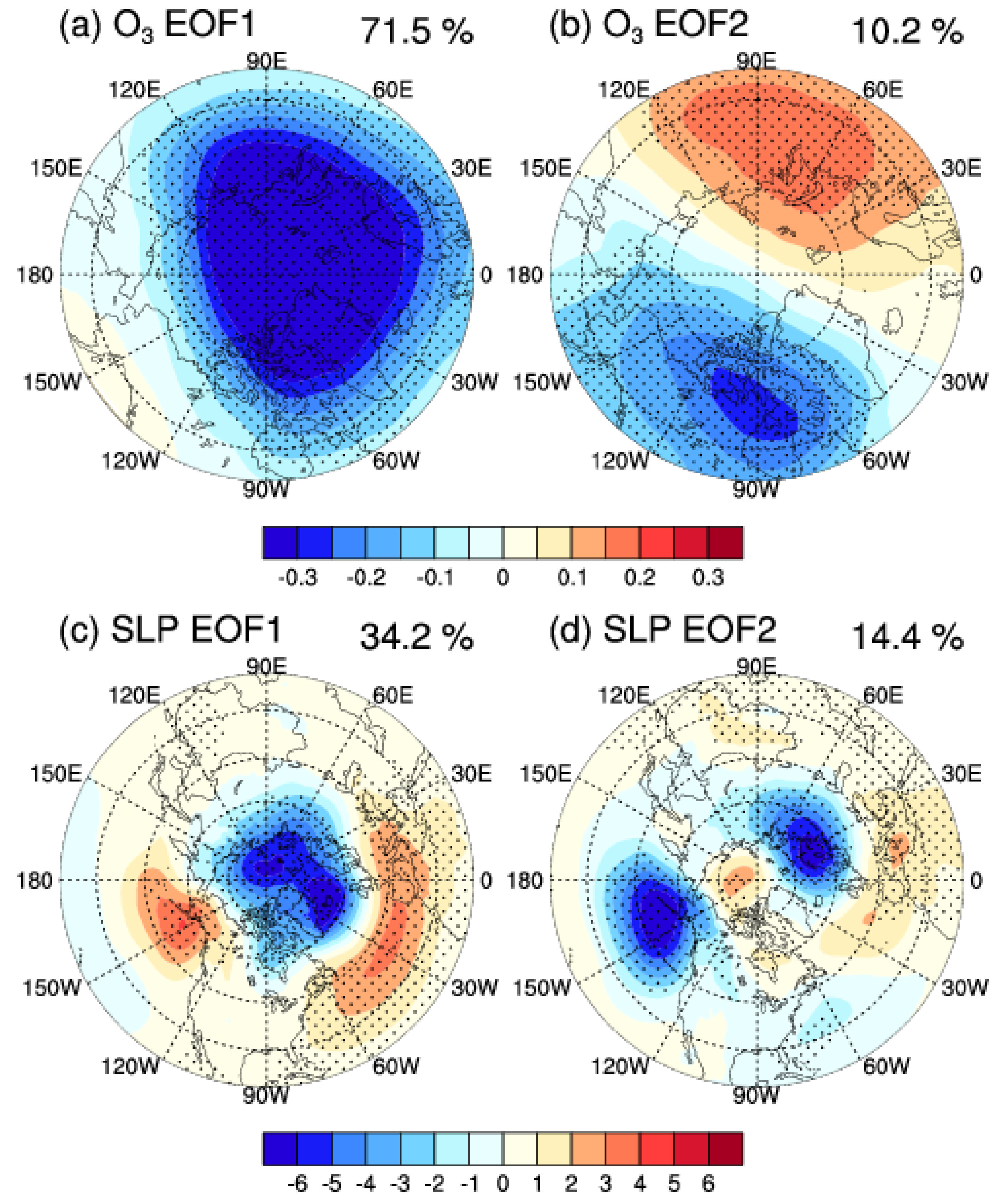



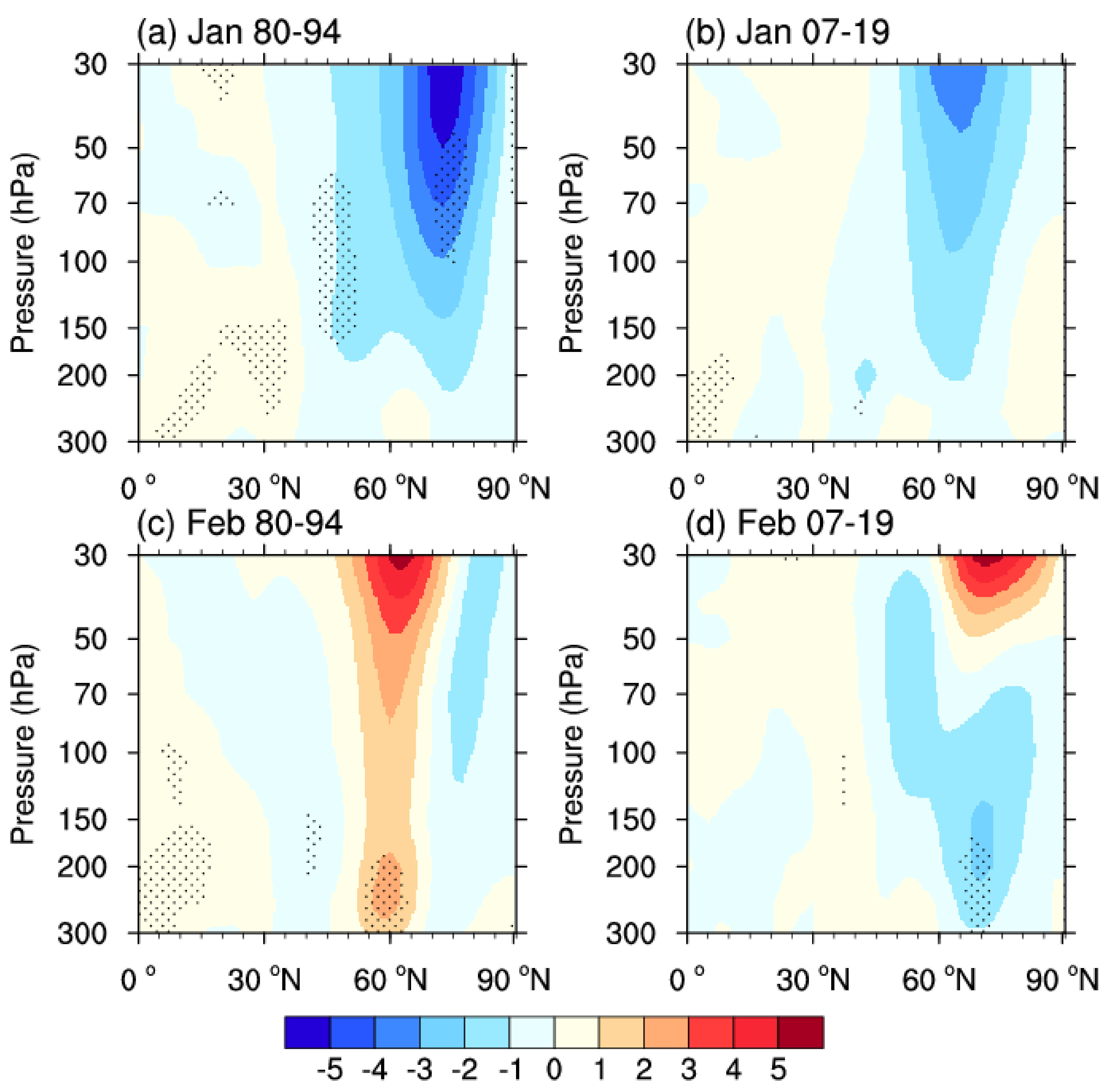
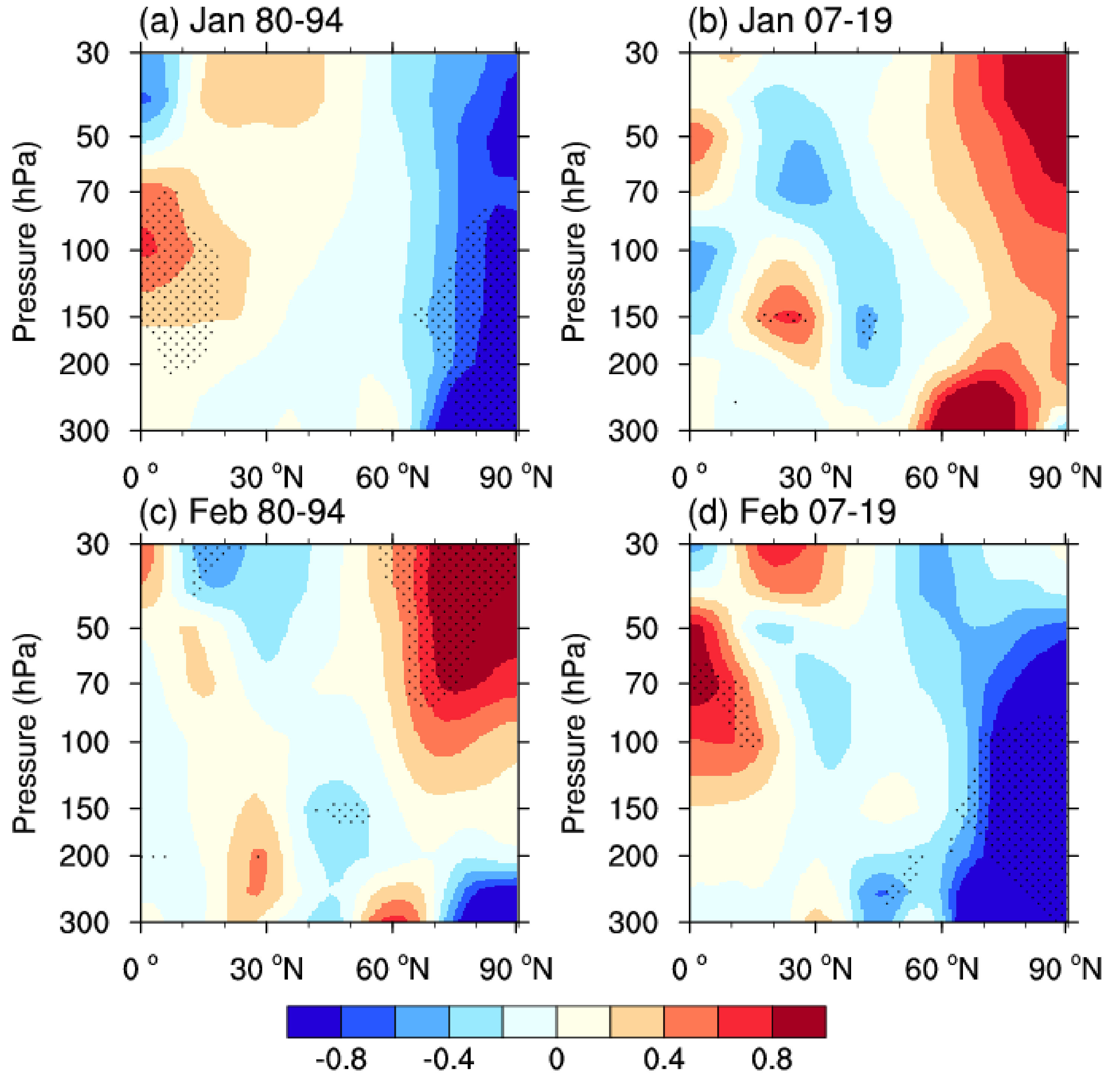

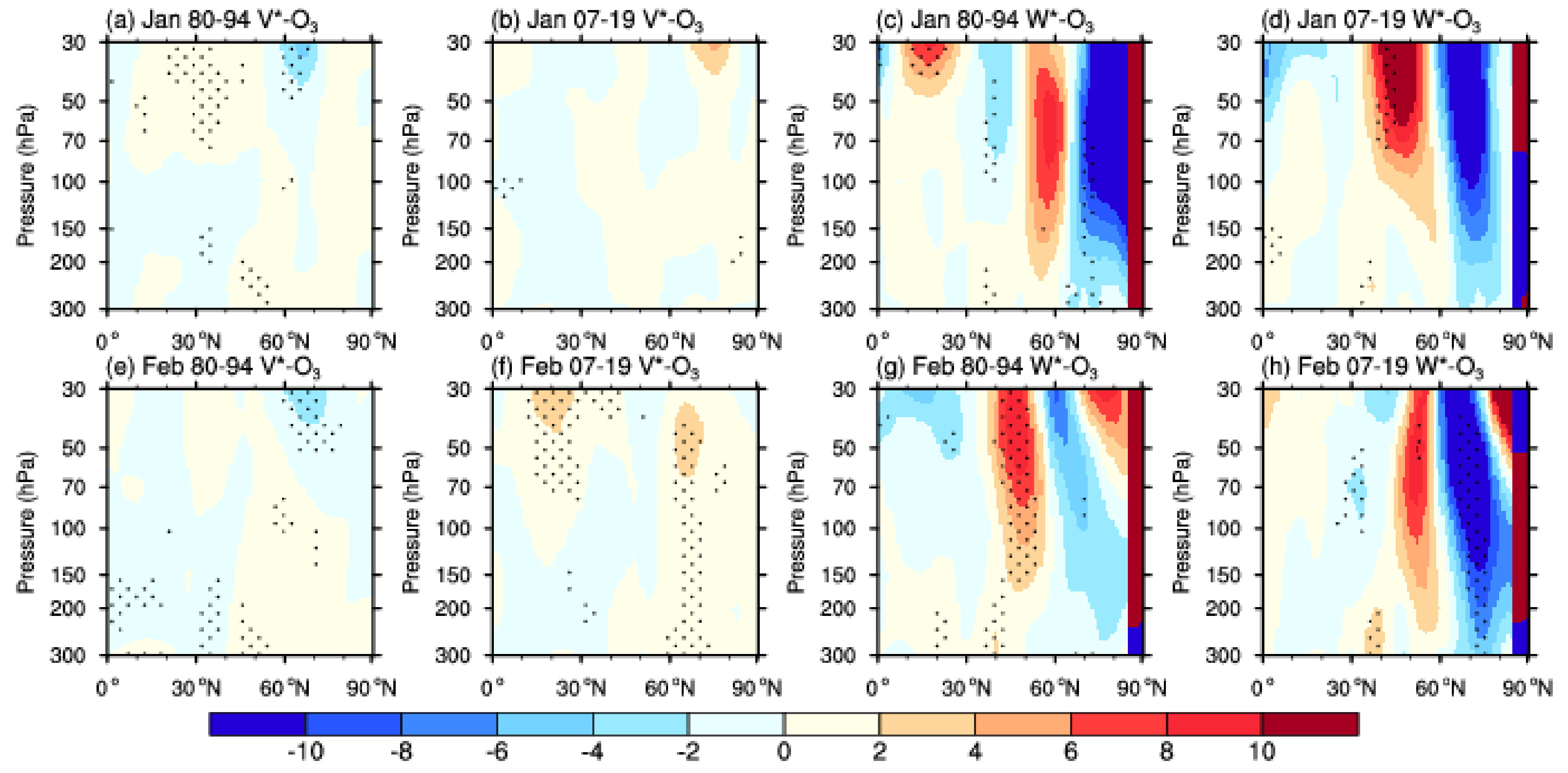

Publisher’s Note: MDPI stays neutral with regard to jurisdictional claims in published maps and institutional affiliations. |
© 2021 by the authors. Licensee MDPI, Basel, Switzerland. This article is an open access article distributed under the terms and conditions of the Creative Commons Attribution (CC BY) license (http://creativecommons.org/licenses/by/4.0/).
Share and Cite
Liu, M.; Hu, D. Different Relationships between Arctic Oscillation and Ozone in the Stratosphere over the Arctic in January and February. Atmosphere 2021, 12, 129. https://doi.org/10.3390/atmos12020129
Liu M, Hu D. Different Relationships between Arctic Oscillation and Ozone in the Stratosphere over the Arctic in January and February. Atmosphere. 2021; 12(2):129. https://doi.org/10.3390/atmos12020129
Chicago/Turabian StyleLiu, Meichen, and Dingzhu Hu. 2021. "Different Relationships between Arctic Oscillation and Ozone in the Stratosphere over the Arctic in January and February" Atmosphere 12, no. 2: 129. https://doi.org/10.3390/atmos12020129
APA StyleLiu, M., & Hu, D. (2021). Different Relationships between Arctic Oscillation and Ozone in the Stratosphere over the Arctic in January and February. Atmosphere, 12(2), 129. https://doi.org/10.3390/atmos12020129





